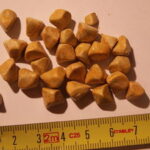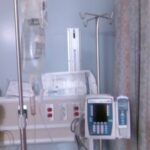The gallbladder is a small sac-like organ located under the liver in the right upper abdomen. Its function is to store and concentrate the bile. Bile is produced by the liver and functions in digestion of fats. The bile is stored in the gallbladder and then released during a meal in response to hormonal stimulus. The liver is connected to the gallbladder and the intestine by bile ducts. Several things can occur which cause disease in the gallbladder.
Stones can form inside the gallbladder. Gallstones are the most common disease of the gallbladder. These stones can be made up of bile pigment and/or cholesterol. No good explanation exists for why some people have gallstones and some do not. Gallstones are more common in women than men. They are more common in women who have been pregnant than women who have never been pregnant. Some researchers propose a hormonal link to formation of gallstones. Once gallstones form, they may be symptomatic or asymptomatic.
Asymptomatic gallstones rarely require treatment. Gallstones that produce symptoms require treatment to avoid complications. Symptoms from gallstones are commonly abdominal pain in the right upper abdomen. This pain may radiate to the back and is usually worse after meals. Associated symptoms can include nausea, vomiting, and fever. Dark urine or gray stool are also possible indications of gallbladder disease. Similar symptoms may be related to ulcer disease in the stomach or intestine. Pain in the right lower abdomen is more likely related to the colon or appendix. Diagnosis of the presence of gallstones is usually done with an abdominal ultrasound. This device uses sound waves to test for the presence of gallstones within the gallbladder. This test can also look for fluid around the gallbladder, measure the size of the bile duct, and look for thickening of the gallbladder wall. This information is important in diagnosing possible complications of gallbladder disease.
Once the diagnosis is made, what are the treatment options? Some medications have been used in the past to try and control gallbladder spasm. Techniques have also been described to break up gallstones. Neither of these provides definitive relief to symptoms. The only long lasting, proven method to prevent complications of gallbladder disease is to have surgery to remove the gallbladder. Historically, surgery to remove the gallbladder required a large open incision in the right upper abdomen. Today most gallbladder removal surgery can be done laparoscopically with three or four small incisions.
General surgeons perform laparascopic gallbladder removal. This is an outpatient procedure and one of the most commonly performed general surgical procedures. Surgery removes the gallbladder and stones eliminating the possibility of infection in the gallbladder (cholecystitis). If this complication develops, the surgery is more likely to have to be open. Recovery is longer and more difficult if infection develops in the gallbladder. Other severe complications of gallstones include cholangitis and gallstone pancreatitis. These can be very severe life threatening conditions. Laparoscopic surgery allows most patients to back at work in 5-7 days. Less narcotic pain medications are required. Full recovery takes 4 weeks.



